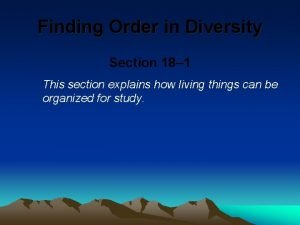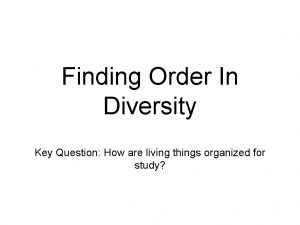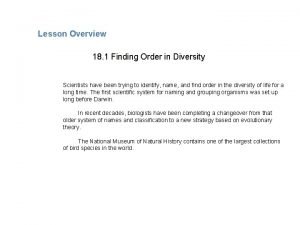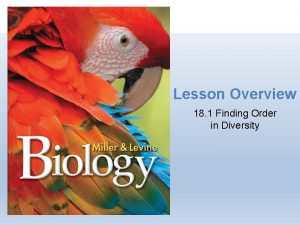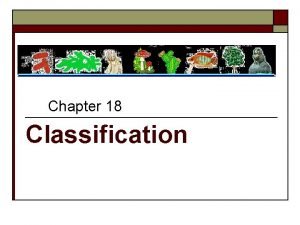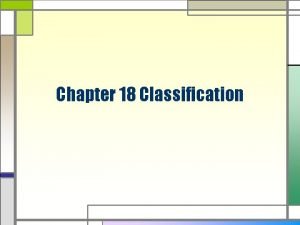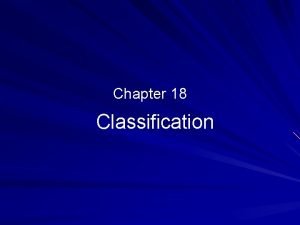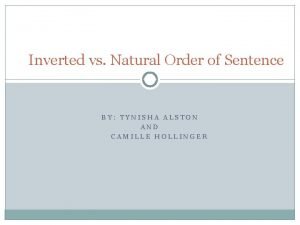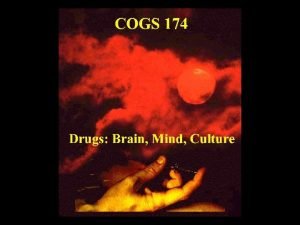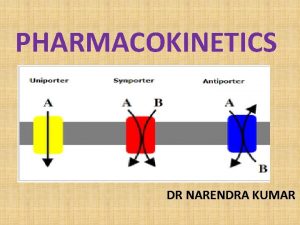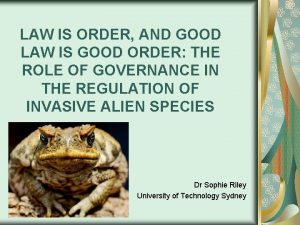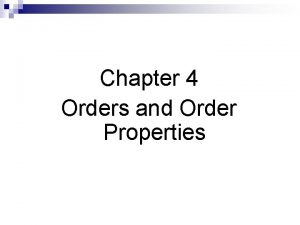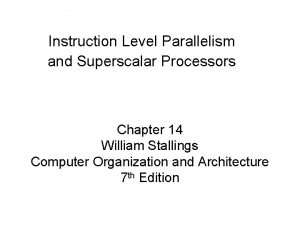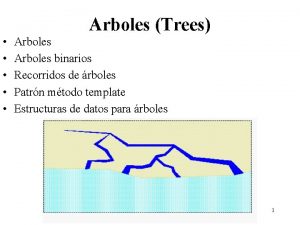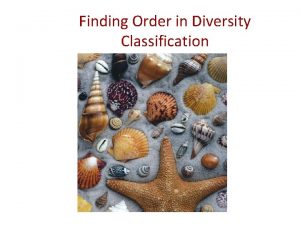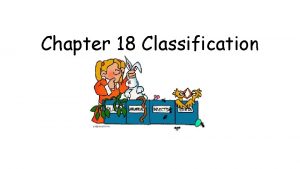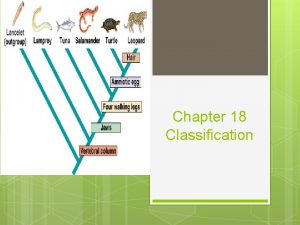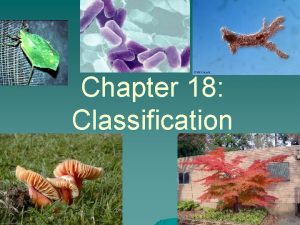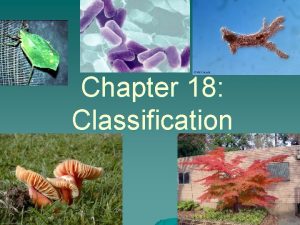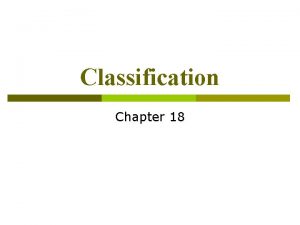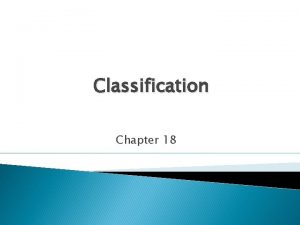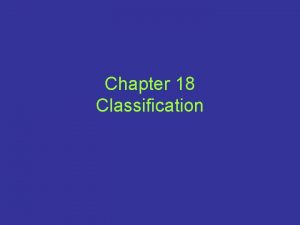Chapter 18 Classification 18 1 Finding Order in

















- Slides: 17

Chapter 18 Classification

18. 1 Finding Order in Diversity I. Assigning Scientific Names □ Common names confusing=varies w/lang & location □ Scientific name (latin) same worldwide The many names of Boletus edulis France: Cepe Puma Cougar Panther German y: Steinpilz United States: King Bolete England : Penny Bun Common names for a mountain lion: Poland: Borowik Finland: Herkkut atti Italy: Porcini Sweden: Stensop p Spanish : Rodelló n

□ Dichotomous key: guide to ID unknown org Ø Uses paired statements with alternate choices

A. Binomial Nomenclature: 1. Linneaus (Swedish botanist) developed 2. 2 -word naming system □ Genus species or Genus species □ Genus=type or group; species=unique description This poison arrow frog's scientific name, Dendrobates azureus, means blue tree-walker! B. Classifying species into larger groups The king vulture Sarcorhamphus papa has a scientific name that means "father or leader with a fleshy, curved beak. " 1. Systematics: organizing life into meaningful groups 2. Taxa: biological groupings

II. Linnaean Classification System A. Uses 7 hierarchical, ordered ranks-taxa 1. Largest to smallest: Kingdom, phylum, class, order, family, genus, species

B. Problems with Traditional Classification 1. Used visible similarities/differences (barnacles look like limpets but are more like crabs) 2. Today: use evolutionary relationships Barnacle: crustacea Crab: Crustacea Limpet: gastropod mollusk

18. 2 Modern Evolutionary Classification I. Evolutionary Classification □ Phylogeny: species grouped by evolutionary descent A. Common Ancestors: taxa groupings show relationships 1. Larger, more diverse taxa=more ancient common ancestor B. Clades-a monophyletic group: single common ancestor and all descendants (living & extinct)

II. Cladogram q Cladistic analysis shows specific traits branch from comm ancestor q Links groups showing evolutionary relationships A. Building Cladograms: branches (nodes) represent ancestral species splitting in 2 1. 2. Each node=last point species above line shared com ancestor Root of node=common ancestor of those more recent

B. C. D. E. Derived Characters: trait arising in most recent ancestor of lineage Losing Traits: tetrapods (4 limbs) include reptiles; snake still reptile Interpreting Cladogram: character positions reflects order they arose Clade vs Traditional grps: evol. links more accurate=clades connects all species back to original ancestor (dinosaurs/ birds/reptile)

III. DNA in Classfication A. Genes as Derived Characteristics 1. Gene homologies (similarities) determine evolutionry relationshps 2. Mutations=derived characteristisc 3. More recent commn ancestors = ↓ diffs in genes (more mutations in common) =>closer related

B. New Evolutionary Trees 1. DNA=more accurate evolutionary tree 2. American vulture looks like African vulture yet DNA & behavior more similar to stork (more recent comm ancestor) 3. Giant panda DNA more like bears; Red panda DNA more like racoons (Pandas now in different clades) African Vulture Amercan Vulture Giant Panda Raccoons Stork Red pandas Giant pandas Common Ancestor Bears Red Panda

18. 3 Kingdoms (6) & Domains(3) I. Changing Ideas about Kingdoms A. W/diversity of life: science moved from Linnaeus’s 2 kingdms to 5 B. Genetic data= bacteria Kingdom Monera divided into 2 C. Genome data=new taxonomic division: Domain (larger than kingdom); now have 3 □ “Protista”: so diverse, > than 1 comm ancestr=not true clade

II. The Tree of Life

A. Domain Bacteria 1. Kingdom Eubacteria 2. Characteristics: a) Unicellular b) Prokaryotic c) Thick Cell Wall □ Peptidoglycan d) Diverse (majority)

B. Domain Archaea 1. Kingdom Archaebacteria 2. Characteristics: a) b) c) d) Unicellular & anaerobic Prokaryotic Cell membranes contain unique lipids Extreme Env’t

C. Domain Eukarya w/4 Kingdoms 1. Kingdom Protista a) b) c) d) Paraphyletic group (more than 1 com ancestor) Plant-like, fungus-like, animal-like members Now at least 5 clades Most single celled 2. Kingdom Fungi a) b) c) d) Feed on dead/decaying org. Cell walls contain chitin Digest externally Most multicellular

3. Kingdom Plantae a) Autotrophic=Photosynthesis b) Cell Wall (cellulose) c) All plants are sister group to red algae (protist) 4. Kingdom Animalia a) Multicellular/hetero b) No Cell Wall/Motile
 1st order 2nd order 3rd order neurons
1st order 2nd order 3rd order neurons Section 18-1 finding order in diversity answer key
Section 18-1 finding order in diversity answer key 18-1 finding order in diversity answer key
18-1 finding order in diversity answer key Finding order in diversity 2
Finding order in diversity 2 Finding order in diversity 1
Finding order in diversity 1 What are the rules for writing scientific names
What are the rules for writing scientific names Section 18-1 finding order in diversity
Section 18-1 finding order in diversity Finding order in diversity
Finding order in diversity Natural sentence order
Natural sentence order First order second order change
First order second order change Buyer seller dyad
Buyer seller dyad Antagonistic effect
Antagonistic effect Difference between 1st order and zero order kinetics
Difference between 1st order and zero order kinetics Law is order and good law is good order
Law is order and good law is good order Order properties
Order properties Instruction level parallelism
Instruction level parallelism Superscalar architecture diagram
Superscalar architecture diagram Arbol in order post order
Arbol in order post order

